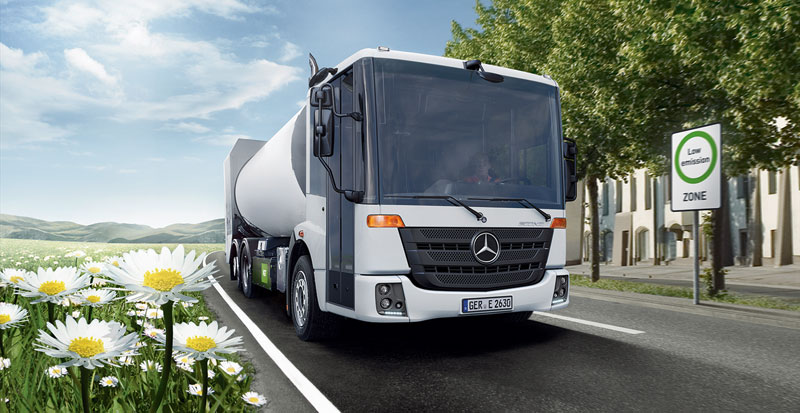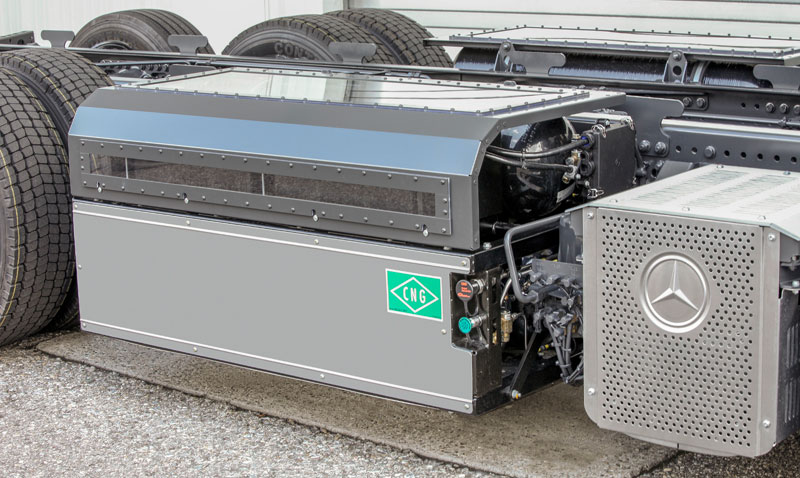- Clean, efficient and quiet drive for urban applications
- Cab: modern design, ergonomic and perfect for the job
- Econic chassis: adaptable with excellent body-mounting ability
It was just one year ago that the Econic underwent a comprehensive upgrade with new diesel engines as well as a new suspension, frame, electronics and a revised cab. Mercedes-Benz has now gone one better with its special-purpose waste collection/short-radius distribution vehicle: the Econic NGT Euro VI with its new M 936 G engine will be launched in August at “Elmia Lastbil Jönköping” in Sweden – an international trade fair for the transport industry from 20 to 23 August 2014. It will make its second major international appearance at Germany’s IAA Commercial Vehicles exhibition. The new six-cylinder in-line powerplant delivers the same performance as a diesel engine while at the same time setting a new benchmark in terms of noise and exhaust emissions.

World premiere in the Econic: Mercedes-Benz M 936 G natural-gas engine
For Mercedes-Benz, sustainability and resource conservation are key to its corporate philosophy. That’s why the Econic NGT (Natural Gas Technology) has been in successful international operation since 2002, with over 1400 units in service.Whether running on fossil-based natural gas or biogas from renewable resources – the Econic far exceeds the required standards while ensuring that urban centres remain clean and environmentally friendly.
Consequently, with its new, state-of-the-art generation of engines, Mercedes-Benz has also further developed the gas drive to comply with Euro VI standards. The result is the new Econic NGT in 1830 and 2630 variants.
Outstanding performance on a par with a diesel engine
The new M 936 G natural-gas engine in the Econic is based on the OM 936 turbodiesel engine from the new 7.7 litre BlueEfficiency Power generation. As a mono-fuel engine (gas-powered only), it runs on compressed natural gas (CNG) and has an output of 222 kW (302 hp) while delivering maximum torque of 1200 Nm. Figures like these, in combination with its impressive power delivery, place the single-stage turbocharged engine on a par with its diesel-powered counterpart. At the same time, it sets new standards in terms of environmental compatibility, with CO2 emissions up to 20 percent below those of a diesel engine. Using biogas2-further improves the carbon footprint.
Specially matched to the needs of CNG operation
To a high degree, the new M 936 G uses the same parts as the engine on which it is based. The cylinder block and cylinder head are the same, having merely been adapted to run on CNG. Newly developed, on the other hand, are the turbocharger, charge-air ducting, ignition and the entire mixture preparation, including exhaust-gas recirculation. The packaging, however, remains identical, with the natural-gas engine having the same dimensions as its diesel-powered counterpart.
The ignition system in a natural-gas engine is identical to that in a petrol engine. The M 936 G uses spark plugs with pencil-type ignition coils. They are housed in the same space that originally accommodated the fuel injectors in the diesel engine. The piston combustion cavity has been given a new geometry for natural-gas operation.
Similarly to a modern-day petrol engine, the new natural-gas engine employs a stoichiometric combustion ratio of lambda = 1, i.e. it uses neither excess air – i.e. a lean mixture such as in the previous engine – nor a rich mixture. This results in especially clean combustion allied to high power output and low pollutant emissions.
A turbocharger with asymmetrical turbine geometry ensures an excellent response from the engine while at the same time supplying the cooled exhaust gas recirculation, the purpose of which in this case is not to minimise the pollutant emissions, but to lower the exhaust-gas temperature in the interests of durability. For design-inherent reasons, the exhaust-gas temperature in a natural-gas engine is higher than in a diesel engine.
The fact that combustion is virtually soot-free obviates the need for a particulate filter of the kind now customary in diesel engines with the introduction of the Euro VI standard. As in a spark-ignition engine, emission control is by means of a three-way catalytic converter.
While meeting the legally required 80 dB(A) limit, the noise level of the new natural-gas engine is even lower across the entire engine-speed range than that of the already quiet OM 936 diesel engine.
Another advantage of the new natural-gas engine is that the extra weight compared with its diesel counterpart has now been halved to just around 500 kg, representing a payload increase of 400 kg over the previous Econic NGT with a wheelbase of 3900 mm. This is due to new gas cylinders in carbon-fibre-encased rugged steel specially produced for a lightweight construction.
Automatic transmission with eco software
Stop-and-go traffic plays a major role in the daily operations of Econic users while also placing special demands on both engine and transmission. For this reason, the powertrain in the Econic continues to include the Allison six-speed automatic transmission – there’s hardly a more agreeable way to navigate in dense urban traffic. The automatic transmission is especially convenient, for example, in connection with the very frequent stopping and starting associated with a waste collection vehicle, for example. For the new generation of Econic, the transmission has been provided with new eco software, which saves fuel while at the same time increasing the ride comfort.
Cab: modern design, ergonomic and perfect for the job
At the heart of the concept behind the Econic – a total of over 13,000 units have been produced since the model series was launched in 1998 – is the ergonomically low-entry and highly spacious cab with its single-step entrance. Wherever driver and front passenger(s) frequently need to leave the cab in the course of their work, this configuration significantly improves their working conditions, including on the health front. The Econic has long since been synonymous with consolidation and distribution operations.
It is evident at first glance that the Econic belongs to the new generation of Mercedes-Benz trucks. The modern design of the Econic cab is characterised by the radiator grille, more rugged bumpers and standard-fit LED daytime running lamps.
The low-entry cab, which has been able to be retained despite the additional vehicle components needed to comply with the newly introduced Euro VI emissions standard, comes with a reconfigured interior.
Driver and passenger(s) in the Econic will now appreciate the cab more than ever with its tried-and-tested low entry and exceptional roominess. The driver benefits from an ideal working environment thanks to the totally revised cockpit with its new multifunction steering wheel, which allows quick access to the instrument cluster display and radio, as well as the individually positionable switches.
The relocation of the parking brake and transmission controls to the same height as the steering wheel makes them easier to use, safer and more ergonomic. There is added stowage space thanks to lockable stowage compartments above the front-passenger seats as well as cup holders in the central console. Behind the front-passenger seats there is also further space for up to three drinks bottles.
Other highlights of the cab include the reconfigured air vents and electrically operated sunblind, which, in combination with more extensive insulation of the cab and engine tunnel, makes for a better working environment inside the cab. Both driver and passenger(s) continue to benefit from a low entry and fully glazed, pneumatically opening folding door on the side away from the traffic.
Success story in a host of variations
The Econic NGT is available in 4×2, 6×4 and 6×2/4 configurations with electrohydraulically and progressively steered trailing and leading axles in permissible gross weight ratings of 18 and 26 tonnes.
The two- and three-axle vehicles come in different wheelbases from 3450 mm to 5700 mm. The cab can be ordered in high (1745 mm inside height) and low (1295 mm) variants.
Econic chassis: adaptable with excellent body-mounting ability
As the Econic offers fundamentally different individual solutions to suit numerous different industries, the changes to the chassis are of great importance for bodybuilders. For instance, the Econic can be used by local authorities as a waste collection vehicle, by food and drinks delivery firms or by fire services as a vehicle with turntable ladder or as an auxiliary fire-extinguishing vehicle. In addition, the Econic is successfully used as a tanker or catering vehicle at airports.
Uniform hole patterns in combination with a movable end cross member and rearranged components behind the cab result in improved body-mounting ability while providing extra implement-mounting space. The load capacity of the front axle has also been increased to eight tonnes.
In line with the common-parts concept behind the Econic, the engine, chassis and axles are put together from the same set of basic components used for the large truck series. This provides customers with significant benefits in relation to servicing and maintenance.
Safety of utmost importance for the new Econic
The tried-and-tested key components of the Econic’s safety concept, such as low and easy entry and exit, health-promoting air suspension on all axles, large panoramic windscreen with mirror system as well as fully glazed, electropneumatically operated folding door on the side of the vehicle away from the traffic, contribute to the safety of both the crew and other road users while at the same time guaranteeing excellent all-round visibility and an especially small blind spot. Added to this is the vehicle’s dynamic handling thanks to the low centre of gravity.
Introduced earlier than required by law, the stability control system (ESP) makes the new Econic safer, as does the electropneumatic braking system. These two assistance systems now augment the existing anti-lock braking system (ABS) and acceleration skid control (ASR) and play a key role in the Econic’s safety concept.
The Econic is always in the best of hands when it comes to maintenance, diagnosis and repair, as Mercedes-Benz has over 1800 service stations in more than 130 countries to make sure that, if the need arises, the vehicles will be well taken care of and kept in top condition. The overall package is rounded off by special service offers and financial services.
Econic at 2014 IAA Commercial Vehicles exhibition
The exhibited Mercedes-Benz Econic 2630 NGT is powered by the new M 936 G natural-gas engine with an output of 222 kW (302 hp). The three-axle vehicle with steered trailing axle (axle configuration 6×2/4 ENA) and 3900 mm wheelbase will be on show as a chassis with cab. This will provide visitors to the exhibition with a clear picture of the technology incorporated in the vehicle. The equipment specification includes a 600 litre natural-gas tank together with an additional tank with a capacity of 100 litres. The power from the engine is transferred to the second axle by means of a six-speed automatic transmission. The Econic is designed for later use as a waste collection vehicle, this being indicated by, among other things, the axle load measuring device. In addition to the driver’s seat, the air-conditioned cab comes with three other seats.


